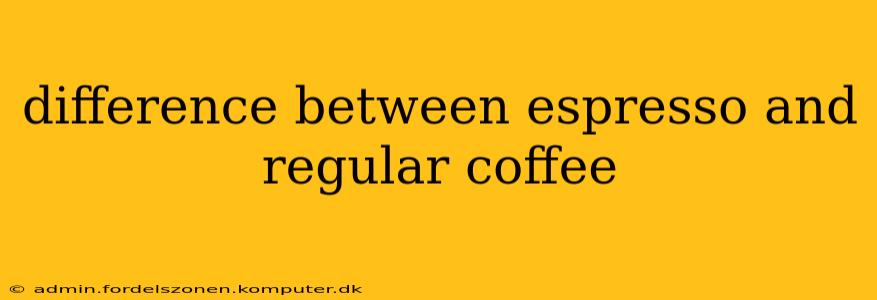Espresso and regular coffee—two titans of the caffeinated beverage world—often get lumped together, but understanding their key differences is crucial for any coffee enthusiast. While both start with coffee beans, the brewing methods, resulting flavors, and even the caffeine content diverge significantly. Let's delve into the specifics.
What is Espresso?
Espresso is a concentrated coffee brew achieved by forcing hot water under high pressure through finely-ground coffee beans. This pressurized brewing process results in a thick, rich, and intensely flavorful shot, typically served in small quantities (1-2 ounces). The short brewing time extracts a complex range of flavors from the coffee grounds.
What is Regular Coffee?
"Regular coffee" is a broad term encompassing various brewing methods, including drip coffee, pour-over, French press, and cold brew. These methods generally involve steeping coffee grounds in hot water for a longer period than espresso, resulting in a less concentrated brew with a milder flavor profile. The resulting cup is usually larger than an espresso shot, ranging from 8 to 12 ounces or more.
Key Differences: A Head-to-Head Comparison
Here's a table summarizing the key differences:
| Feature | Espresso | Regular Coffee |
|---|---|---|
| Brewing Method | High-pressure water extraction | Various methods (drip, pour-over, etc.) |
| Water Quantity | Small (1-2 ounces) | Larger (8-12 ounces or more) |
| Brewing Time | Short (20-30 seconds) | Longer (several minutes) |
| Coffee Grind | Very fine | Medium to coarse |
| Flavor Profile | Intense, concentrated, complex flavors | Milder, more nuanced, varying by method |
| Caffeine Content | Relatively high (per ounce) | Relatively lower (per ounce) |
| Crema | Typically features a rich crema layer | No crema layer |
How Much Caffeine is in Each?
Caffeine Content: Espresso vs Regular Coffee
While espresso shots generally per ounce have a higher caffeine concentration than regular coffee, it's crucial to consider serving size. A single espresso shot might have less caffeine than a large mug of regular coffee. The actual caffeine content varies drastically based on bean type, roast level, and brewing method.
What's the Best Choice for Me?
The "better" choice depends entirely on personal preference.
-
Espresso lovers appreciate the intense flavor and bold crema, often enjoying it as a standalone beverage or as the foundation for lattes, cappuccinos, and other espresso-based drinks.
-
Regular coffee drinkers value the more approachable, often smoother flavor and larger serving size. The brewing method offers a degree of control over the flavor profile.
Frequently Asked Questions (FAQs)
Can I make espresso at home?
Yes, you can make espresso at home with a dedicated espresso machine. These range in price from budget-friendly models to high-end professional-grade machines.
Which one has more caffeine?
The caffeine content per ounce is generally higher in espresso, but the total caffeine intake depends on the serving size. A large cup of regular coffee might have more caffeine than a single espresso shot.
What is crema?
Crema is the reddish-brown foam that sits atop a properly pulled espresso shot. It's a sign of a well-extracted espresso and contributes to its rich flavor and texture.
Can I make espresso with a regular coffee maker?
No, you cannot make true espresso with a standard drip coffee maker. Espresso requires high water pressure for optimal extraction.
This comprehensive guide clarifies the differences between espresso and regular coffee, hopefully equipping you to make an informed choice next time you reach for your morning brew. The world of coffee is vast and varied—experiment and discover your personal favorite!
